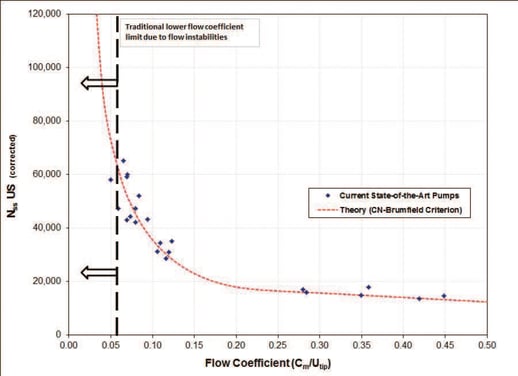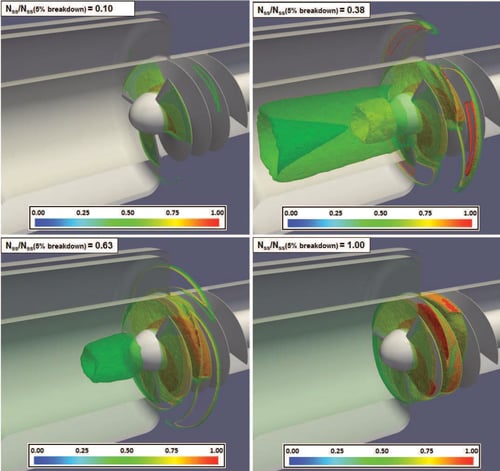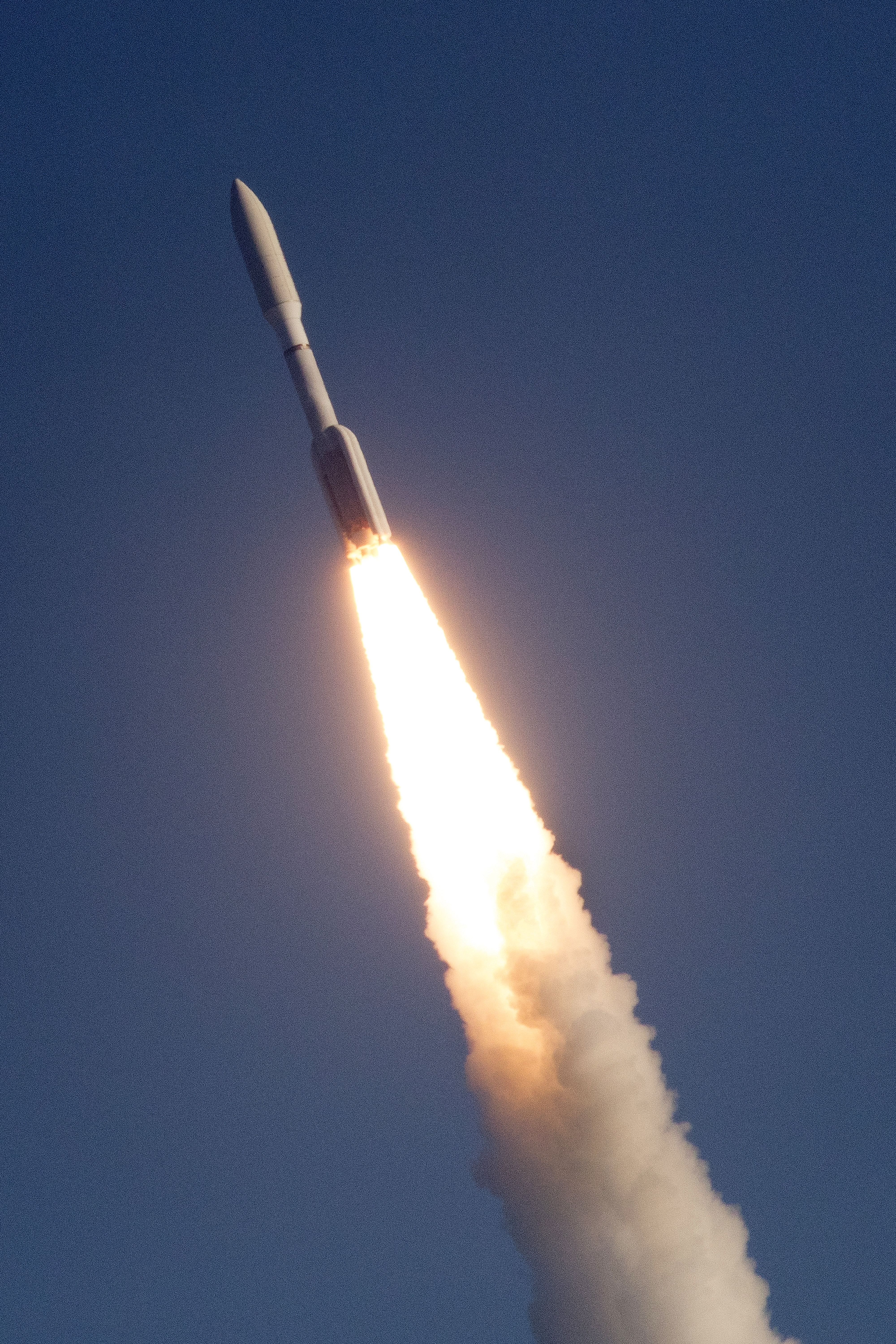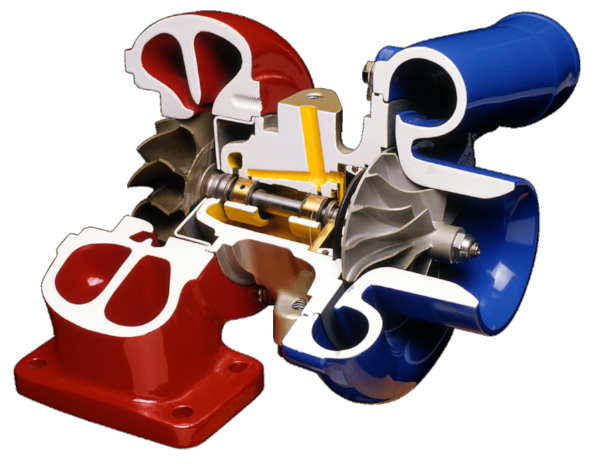The path to better operation stability and robustness
High suction performance pump inducers are critical to important industrial and advanced aerospace applications where the required inlet pressure is near the vapor pressure of the liquid to be pumped. These include boiler feed pumps, liquefied natural gas (LNG) transfer pumps, aircraft fuel pumps and space vehicle propellant pumps. Improving the efficiency of moving natural gas from production sites to where it is used is an increasingly important application for high suction performance inducers. Over the past 17+ years, Concepts NREC has been researching ways of improving inducer design to advance inducer suction performance, operational range, stability, and structural robustness.
The inducer’s role is to raise the pressure of the liquid to a sufficient level so that downstream components can pump the process liquid to the required pressure without cavitation.
Cavitation occurs when the local pressure inside the pump drops below the fluid vapor pressure. At this point, a vapor cavity forms, usually on the blade suction surface upstream of the inlet throat, which leads to debilitating effects on the pump.
The inlet pressure is critical in determining the likelihood of pump cavitation. An inlet pressure above the vapor pressure of the liquid is desirable to reduce or eliminate the impact of cavitation. However, in many applications, high inlet pressures are not practical. For example, LNG transfer pumps need to operate at low pressures when storage tanks are nearly empty, to extract as much of the LNG as possible. Space launch vehicles are weight limited, and higher tank pressure means higher tank weight, which in turn, impacts launch costs. In these systems, it is desirable to keep the inlet pressure as close to the vapor pressure as the pumps will allow. The net positive suction head (NPSH) is the parameter used to judge a pump’s capacity to pump without cavitation. The NPSH is defined as the inlet total head minus the vapor head of the propellant where the pump experiences a 3 to 5% loss in head rise.
Pumps operating at lower values of NPSH are more resistant to cavitation and have higher suction performance. A pump’s NPSH is dependent upon the impeller geometry, flow rate (Q), and rotational speed (N). To reduce the number of independent parameters and to compare different pumps, it is common to combine the NPSH, flow rate, and rotational speed into a non-dimensional group called the suction specific speed (Nss) defined in Equation 1. Common usage in the U.S. is to use units of rpm, GPM, and feet, and to drop the acceleration of gravity constant, which results in a dimensional parameter that is still used as if it were dimensionless. This parameter is called NssUS.
Equation 1
Figure 1 shows a plot of NssUS versus inlet flow coefficient for test data from a variety of pumps at their design point, from high flow coefficient to low flow coefficient. High flow coefficient pumps are common in many industrial/commercial applications and have Nss-US values below about 20,000. Low flow coefficient pumps are used in aerospace applications or industrial applications that require high suction performance with values of NssUS in the range of 25,000 to 65,000. One observation from Figure 1 is that suction specific speed is inversely proportional to the flow coefficient. At high flow coefficient, the variation in suction specific speed with flow coefficient is flat, and suction performance changes are seen through changes in the blade thickness and shape near the leading edge. Because of this, designers of industrial pumps frequently fail to recognize the influence of design point flow co-efficient on suction performance, and efforts to raise the suction performance of high flow coefficient pumps are often not successful. As the flow coefficient drops below approximately 0.20, the influence of flow coefficient on suction performance is more pronounced.

Figure 1 - Suction specific speed versus inlet flow coefficient for a wide range of pumps. The pumps on the right are typical industrial-type pumps, while the pumps on the left are low flow coefficient, high suction performance inducers.
A theoretical curve of suction specific speed versus flow coefficient that was developed by Concepts NREC is shown in Figure 1. It is a synthesis of two techniques that have been used widely, depending on the flow coefficient of the pump. At low flow coefficients below 0.15, pump designers use what is known as Brumfield’s criteria to estimate an appropriate flow coefficient to achieve a required level of suction specific speed. Brumfield’s criteria are a reflection of the trade-offs between the bulk inlet flow velocity, flow angle and blade tip speed on the suction specific speed. The data in Figure 1 track the theory well, with the variance probably due to specific blade shapes and thickness variations that affect the suction performance, but are not accounted for in the theory.
A good portion of the pump research at Concepts NREC has investigated inducer design at low flow coefficients using theoretical analysis and water rig testing. Initial research focused on different blade design methodologies for improving suction performance in the range of flow coefficients (0.06 to 0.12). While modest success was achieved, it quickly became apparent that any significant increase in suction performance would require a reduction in flow coefficient. The problem is that there is a kind of stability barrier at a flow coefficient of approximately 0.06. When approaching this point and below, it is difficult to design an inducer that does not exhibit significant inlet backflow and cavitation-induced instabilities, especially if the inducer is required to operate at a low-flow off-design point. As the flow coefficient decreases, the inlet relative flow angle sures. The normalized suction specific speed changes from 0.1 to 1.0, with the normalization factor as the suction specific speed at the 5% head breakdown point. At 10% of maximum normalized Nss, there is vapor forming on the blades, which is typical of all inducers. At the intermediate levels of suction specific speed, there is a vapor cavity just upstream of the inducer that is probably due to the interaction of the stability control device with the upstream flow. This upstream vapor cavity does not appear to have any impact on the inducer suction performance or stability. At the 5% head breakdown point, there is vapor cavity blockage within the inducer blades, as is typical for other inducers. However, in this case, it is running stably at a flow coefficient well below the current stability limit, and the head breakdown is at a much higher suction specific speed than the current state-of-the-art.
The next phase of development will be to test the technology in Concepts NREC’s pump flow loop testing facilities. These tests will gather information on head, efficiency, and cavitation performance, with particular attention paid to high-frequency pressure measurements to show the technology’s stability characteristics. After water rig testing, development efforts will focus on testing in fluids such as LNG and liquid hydrogen as measured from the tangential direction also decreases, and the blade angle must decrease with it. At low tangential blade angles, the inlet becomes sensitive to small changes in incidence angle, and it is easy to stall the flow at the inlet tip.
To overcome the stability barrier, Concepts NREC focused on researching inlet cover treatment devices to stabilize the flow at low flow coefficients. Several variants were tested, and the most successful improved the stability of low flow coefficient inducers around the current stability barrier – this device was subsequently patented by Concepts NREC. While there have been other devices proposed and tested by researchers attempting to overcome the stability problems at low flow coefficients, rig testing indicates that the Concepts NREC device is the most effective and shows the most promise for reducing the flow coefficient stability barrier.
Concepts NREC is currently investigating how to move the stability limit, shown in Figure 1, further to the left. The early findings are encouraging, and Concepts NREC is filing additional patents. A large portion of the research to this point has been undertaken with computational fluid dynamic (CFD) simulations that were first validated with test data taken in Concepts NREC’s pump lab. Two-phase, time-dependent calculations were made on various configurations at different inlet pressures to simulate the cavitation head breakdown characteristics of an actual pump rig test. Figure 2 shows plots of vapor volume fraction contours in the computational domain at four inlet pressures. The normalized suction specific speed changes from 0.1 to 1.0, with the normalization factor as the suction specific speed at the 5% head breakdown point. At 10% of maximum normalized Nss, there is vapor forming on the blades, which is typical of all inducers. At the intermediate levels of suction specific speed, there is a vapor cavity just upstream of the inducer that is probably due to the interaction of the stability control device with the upstream flow. This upstream vapor cavity does not appear to have any impact on the inducer suction performance or stability. At the 5% head breakdown point, there is vapor cavity blockage within the inducer blades, as is typical for other inducers. However, in this case, it is running stably at a flow coefficient well below the current stability limit, and the head breakdown is at a much higher suction specific speed than the current state-of-the-art.
The next phase of development will be to test the technology in CN’s pump flow loop testing facilities. These tests will gather information on head, efficiency, and cavitation performance, with particular attention paid to high-frequency pressure measurements to show the technology’s stability characteristics. After water rig testing, development efforts will focus on testing in fluids such as LNG and liquid hydrogen for space propulsion applications.
CN’s research to improve suction performance and increase the stability of pump inducers shows great promise for significant gains over the current state-of-the art technology. These gains will reduce costs, increase reliability, and generally improve the capability of a number of important industrial and aerospace pumping systems.

Figure 2 — Plots of vapor volume fraction for two-phase, time-resolved fluid dynamics simulations of an inducer/stability control system. The simulations start at high inlet pressure and progress to lower inlet pressure or higher Nss values.








